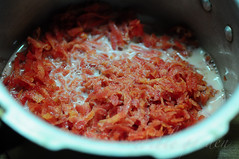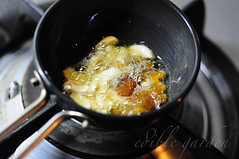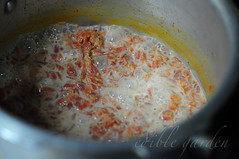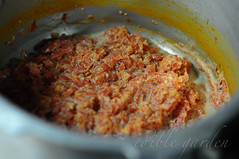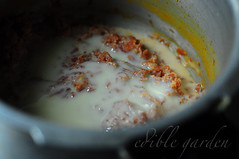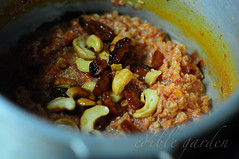Choose
the best red cabbage by selecting one that feels heavy,
is bright and has crisp leaves. Avoid any that have puffy leaves
or outer layers removed.
- Red cabbages are easy to prepare. Strip off the outer leaves, wash, then slice into quarters, cut out the hard central core on each, then chop or shred.
- Lock in the color by adding a touch of vinegar when cooking red cabbage in water. This stops the lovely deep purple hue from running.
- Don’t be too heavy-handed with red cabbage. A lot of its frumpy reputation comes from it being over-pickled or boiled for an eon. Although it’s a sturdy vegetable it’s not invincible…
- Go raw.
Lock in nutrients by eating your red cabbage uncooked in salads. Just
make sure you slice it very finely.
Here
are some suggestions for what to do with your beautiful red cabbage! (This link "German
Food" will also take you to a website with a number of red
cabbage recipes.)
Pickled
Red Cabbage (This is a personal favorite)
Ingredients
- 1 lb red cabbage, finely shredded
- 1 1/4 Tbs. coarse sea salt
- 2 cups cider vinegar
- 3/4 red wine
- 1 1/4 granulated sugar
- 2 tsp black peppercorns
- 6 bay leaves
- 2 tbsp yellow mustard seeds
2. Put the vinegar, wine, sugar, peppercorns and bay leaves into a big, wide saucepan and simmer until the liquid has reduced by about half. Set aside for 10 mins to infuse.
3. Strain through a fine sieve (cheesecloth works, too)into a jug or bowl, and discard the peppercorns and bay leaves. Put the cabbage and mustard seeds into a big bowl, and then pour the strained liquid over. Transfer the cabbage and pickling liquid into sterilized jar(s) and seal. Will last for a month in the fridge
"Purple
Stuff" Red Cabbage Rolls
Ingredients
- 1 large red cabbage
- 2 lb lean ground beef
- 2 large onions, chopped
- 2 medium green bell peppers, chopped
- 2 medium red bell peppers, chopped
- 2 medium yellow bell pepper, chopped
- 1 Tbsp garlic, minced
- 1 c brown rice, cooked
- 1/2 c stove top stuffing ( or use bread crumbs made with fresh bread instead of dry)
- 2 can(s) tomato soup
- 1 can(s) chicken broth
- 1 c tomato juice
- 1 can(s) mushroom pieces
- garlic pepper season to taste
- salt season to taste
- 2-3 dash(es) Worcestershire sauce
Directions
1. Prep
day before you plan to cook these: Leave your red cabbage in the
plastic bag and place in the freezer. Leave in for 12 hours or
overnight. Remove and leave to thaw at room temperature. The leaves
will be soft and easy to use without having to boil them.
2. Cook
the rice and set aside to cool.
3. In
light olive oil, saute onions, mushrooms, and peppers until the
onions are golden brown and set aside to cool.
4. In
a large bowl, add the ground beef, add the salt, garlic pepper, Stove
Top stuffing, Worcestershire sauce, sauteed onions and the rice. Mix
together until combined.
5. Remove
the leaves from the cabbage, cutting away the tough part closest to
the core in the shape of a V. Spray your large casserole or two small
casserole dishes with cooking spray.
6. Put
about a 1/3 to 1/2 cup meat mixture at the bottom of the leaf, tuck
in your corners at the "V" and roll up tightly. The meat
amount will vary depending on the size of the leaf. Repeat until all
the meat is used up or all leaves are gone. If you have any meat
mixture leftover, freeze it for later.
7. In
a large mixing bowl combine the tomato soup, juice, and broth. Pour
evenly over the cabbage rolls. Cover with foil.
8. Bake
the cabbage rolls at 325 for two hours.
